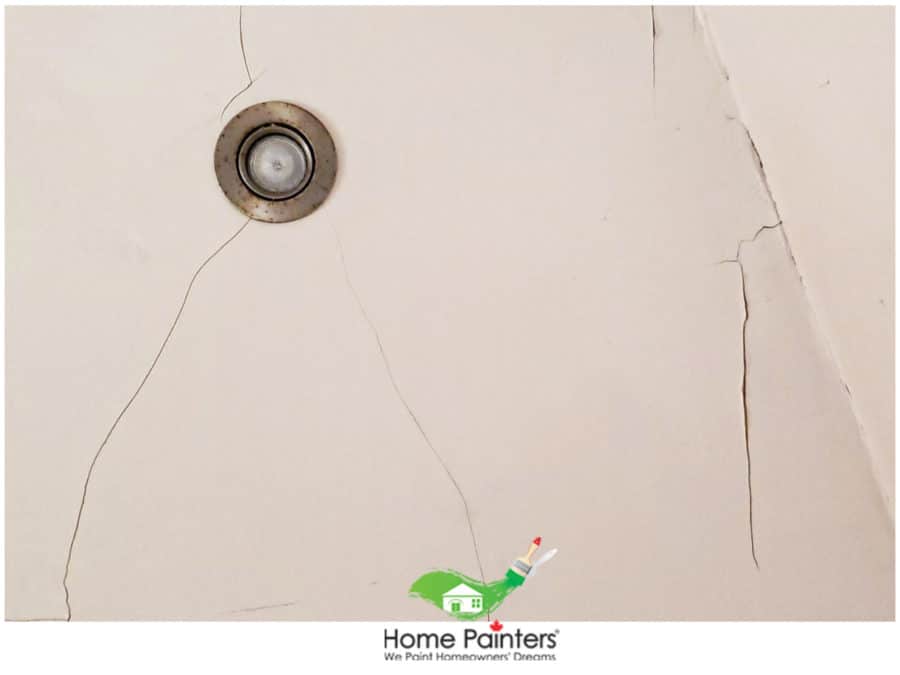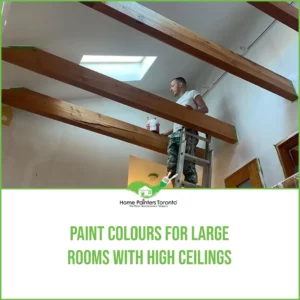
Why is your ceiling paint peeling? There are several factors that can cause this issue. It could have to do with extra moisture or improper painting techniques and practices. We’ll list all the possible reasons further below.
Can I Paint Over A Peeling Ceiling?
Yes, you can paint over a peeling ceiling. However, it’s important that you understand the peeling paint on the ceiling causes before you decide to paint over it. You can’t just slap some new paint on there and expect it to look good. A lot of times there are underlying issues that need to be corrected before painting over them. If you don’t address the underlying issue, it’ll just come back and will require more work in the future.
Luckily, no matter the cause, the repairing process for peeling paint on a ceiling is similar. You will need to remove all of the flaking or peeling paint and fill and plaster the surface. You’ll need to sand it until smooth, prime and seal the damaged areas. Then apply a new coat of paint. As always, Home Painters Toronto is the painting company here to help with the process! We have your back when it comes to all the right painting tips as well as repair work. So, let’s dig in!
Top Reasons For Plaster Ceiling Paint Peeling
There are a number of reasons why you might see paint on plaster ceilings that are peeling in your home.
Here are some of the top reasons:
- When you started painting your ceiling while there was high humidity or lots of moisture in the air, you might find your ceiling paint peeling from that.
- Another reason for ceiling paint peeling could be a water leak. Once that moisture gets into the ceiling, it will make itself known in various ways. You might see some watermarks or the paint may simply start to peel or bubble up.
- If you’re looking at ceiling paint peeling in your bathroom, it could have to do with a build-up of soap and scum that has caused the peeling. You might see this, especially around the shower or bathroom, toilet or sink area. This can occur in the kitchen as well.
- Always be careful and watch your candles after you light them! You will definitely take notice of your ceiling if there has been lots of smoke or even fire damage
- Has it been 10+ years since you’ve painted your ceiling? Like anything else, paint does age. You might see some ceiling paint peeling from normal wear and tear as well.
- Now that you find peeling paint on walls, check out this blog to help fix it!

Always Protect Your Floors and Furniture
As with anything, there are a few steps to the process of fixing a peeling plaster ceiling. Here’s what you need to do to properly protect your furniture and flooring prior to repairing the peeling plaster ceiling:
- Before you get started, remove all of the furniture from the room.
- Move it all to the middle of the room if you can’t remove it and spread drop sheets over them.
- Tape the drop sheets to the base of the furniture and tuck the corners under any legs to be sure that all surfaces are well protected.
- Use drop sheets on the floor as well – whether it’s hardwood, laminate, or carpet.
- When you take the time to properly cover up and protect your flooring and furniture, you won’t be left with any clean-up afterwards! No one likes cleaning up paint spills.
Materials Needed to Fix a Peeling Plaster Ceiling:
- Drop cloths
- Painter’s tape
- Stepladder
- Face mask and safety goggles
- Putty knife
- Scraper
- Medium-grit and fine-grit sandpaper
- A bucket or pan for debris collection
- Plaster or filler
- Paint brush and paint roller
- Interior primer
- Paint tray
- Interior ceiling paint

Safety First
- Safety is the most important part of any home painting or renovation job.
- You can always ask a friend to help! This will ensure there are always two people around, which is important for using ladders and doing work on the ceiling.
- If you are doing this job yourself, remember that old paint may contain lead. It can be dangerous. If you’re super worried about this, always consult a professional painting company.
- Always equip yourself with the proper safety gear. Use a face mask to avoid breathing in the dust. Goggles are a good idea as well. The primer or paint could drip down on you while you paint. This has the potential of causing long-term damage.
- Use a stepladder to reach up to the ceiling for repair work. Always get someone to hold on to it for you to make sure it’s stabilized and you’re safe.
Fixing Plaster Ceiling Paint Peeling
- First, you have to prepare the surface so the new ceiling paint will have something solid to stick to.
- Stand on a ladder and scrape off all the loose peeling paint using a putty knife or scraper.
- Use a knife to pry off the peeling paint that is still stuck to the plaster surface area. Hold a pan under the knife to stop the paint from falling directly on the floor and leaving a mess to clean up later.
- Fill and plaster the damaged areas so it’s more level.
- Leave the filler to properly dry for an hour or two.
- Once it’s dry, go in with medium grit. Then fine-grit sandpaper to eliminate the blemishes until smooth.
- Blemishes can be hard to see, even in daylight. Use a flashlight to spot imperfections then sand them down so there are no bumps.
How to Repair Peeling Paint on Textured Ceiling
The process is a bit different if your ceiling is textured. It’s important to be very careful when removing the peeling paint. You don’t want to remove too much of the texture or lose any parts of it.
- Start by peeling off all loose paint with a putty knife.
- Then lightly sand the area until smooth and even.
- Fill in any holes or dents with spackling compound.
- Let this dry for an hour or two before doing any heavy cleaning.
- After the spackling compound dries, clean the area with a damp rag. This will remove any remaining dust and debris. Lightly sand it off again if you still see paint on the surface of your ceiling. While being careful not to damage your texture. Clean the area with a damp cloth to remove any dust. You can also use paint thinner, but it’s not necessary.
- Let it dry for 24 hours before priming and painting your ceiling again.
Primer is Vital for Protection from Peeling
- Primer stops moisture damage and paints peeling on the ceiling from happening again. This increases the lifespan of your new paint. If water problems are common, it’s best to use an oil-based primer, since this will leave absolutely no room for any moisture. We recommend the Kilz Odour-less Oil Primer.
- If it’s the ceiling in your bathroom, we suggest Benjamin Moore’s Fresh Start Primer. It’s mildew resistant, fast drying and offers great adhesion.
- Apply the primer of your choice to your ceiling with a paint roller.
- Make sure you get all the edges.
- Let the primer dry completely before you continue with any ceiling paint.

- We always recommend that you repaint the entire ceiling, not just the patch that you just repaired because of peeling paint.
- Even if you’re using the same colour, brand, and finish of interior paint, there will be a noticeable difference in colour from age and weathering.
- Sherwin Williams Duration Home Interior Acrylic Latex Paint is good paint and primer in one. It’s recommended for ceilings in a satin finish.
- Apply a layer of paint with a roller. It’s often best to start in the corner and work your way from there.
- You can use a smaller paint brush for the edges near the walls.
- Leave the first coat some time to dry. At least 4 – 6 hours is recommended. If you have a full day, that’s even better.
- Then apply a second coat of interior paint to your ceiling.
The Best Interior Ceiling Paint
As usual, it really makes a difference when doing an interior painting to go with the best interior house paint on the market. After all, you want it to last a number of years and you want your ceiling to look its best. It can be considered the fifth wall in a room! One of the best interior ceilings paints out there is Benjamin Moore Waterborne Ceiling Paint. It works exceptionally well to hide any flaws, has low VOC and offers the flattest finish Benjamin Moore has to offer. It’s important to find good paint for ceilings that hides imperfections. Because they can often be highlighted if you use the wrong gloss level.
More Interesting Blogs Related to
“How To Fix A Peeling Plaster Ceiling”
Now your ceiling is patched and ready! That’s all there is to it! But if you don’t find this kind of work a-peeling, why not let Home Painters Toronto take care of it for you? With over 34 years of experience as a top-rated Toronto Painter in home painting and renovation. Our team of house painters can get this done for you on time and efficiently, making your ceiling look as good as it ever has.
Call us at 416-494-9095 or email us at [email protected] to get a FREE quote for your peeling ceiling repair. And don’t forget to follow us on our social media channels below!





